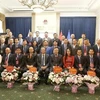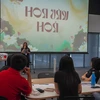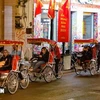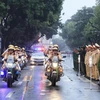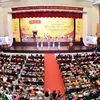Making glass from beach sand? Forget it! Students from Hue University of Science are using a new technique to make liquid glass from rice husks and ash.
Ho Phuoc Diep, Nguyen Thi Le Giang and Tran Thi Lien came up with the idea after reading an article that husks and ash contain a high volume of silicon dioxide (SiO2), a key compound for the creation of the liquid, or natri silicat (Na2O.nSiO2).
The glass can be used for making waterproof paint, soap, cloth shoes and ceramics. The demand for liquid glass in Vietnam is thousands of tonnes each year, but current manufacturing processes involve complicated technology for baking white sand in a kiln heated to 1,300 degrees Celsius.
"The SiO2 in husk and ash can easily be turned into liquid glass at much lower temperatures, which means the price can be dramatically reduced. And as Vietnam is still an agricultural country, we have a lot of husks and ash," Diep said.
Diep said the team came across many challenges during their experiments, from searching for relevant documents to designing experimental tools and finding a standard production process.
It took them eight months before they finally succeeded. The students now hope to test their laboratory success on an industrial scale.
The project was one of the outstanding works that won awards for Young Science Talent in 2014. The competition was run by the Ministries of Education and Training, and Science and Technology, with help from the Vietnam Chamber of Commerce and Industry and other organisations. The award aims to encourage lecturers and students in innovation.
Four students from the Hanoi University of Industry, Duong Van Thien, Pham Van Sang, Phan Van Nghiem and Kieu Thanh Son, won another prize for a pilotless aircraft.
After two-and-a-half years work, the students developed a drone with a range of one kilometre and a ceiling height of 500 metres.
It is capable of transmitting data back to computers on the ground. Thien, the group's leader, said they learned from their mistakes, and lost their drone several times.
"We then wrote our phone number on it so people could call us if they found it," he said.
The students, who spent 30 million VND (1,400 USD) on the project, avoided flying their drone near lakes in early tests. "It can fly on a designated route now, but we still need to use hand-held manual controls for take off and landing," Thien said. "I hope other students can help perfect our design."
Demand for domestic workers in big cities is high and continues to grow, but the pool of labour is drawn mostly from women in rural areas who have little exposure to technology, particularly the array of electronic devices increasingly common in urban homes.
So, a group of students from Hanoi Economics University began a project to assess the capability of helpers and find out what training they needed.
Group leader Nguyen Nguyet Minh said, "We had to interview a large number of people before we could get an adequate sample for data analysis. This, on top of our classes and homework, was a strain. Sometimes, we felt like giving up because many people refused to be interviewed."
Minh's group developed a model for training workers and developing a skills-based system that will match them with prospective employers. "We hope our project will encourage the authorities so helpers can be more professional and have stable jobs," Minh said.-VNA
Ho Phuoc Diep, Nguyen Thi Le Giang and Tran Thi Lien came up with the idea after reading an article that husks and ash contain a high volume of silicon dioxide (SiO2), a key compound for the creation of the liquid, or natri silicat (Na2O.nSiO2).
The glass can be used for making waterproof paint, soap, cloth shoes and ceramics. The demand for liquid glass in Vietnam is thousands of tonnes each year, but current manufacturing processes involve complicated technology for baking white sand in a kiln heated to 1,300 degrees Celsius.
"The SiO2 in husk and ash can easily be turned into liquid glass at much lower temperatures, which means the price can be dramatically reduced. And as Vietnam is still an agricultural country, we have a lot of husks and ash," Diep said.
Diep said the team came across many challenges during their experiments, from searching for relevant documents to designing experimental tools and finding a standard production process.
It took them eight months before they finally succeeded. The students now hope to test their laboratory success on an industrial scale.
The project was one of the outstanding works that won awards for Young Science Talent in 2014. The competition was run by the Ministries of Education and Training, and Science and Technology, with help from the Vietnam Chamber of Commerce and Industry and other organisations. The award aims to encourage lecturers and students in innovation.
Four students from the Hanoi University of Industry, Duong Van Thien, Pham Van Sang, Phan Van Nghiem and Kieu Thanh Son, won another prize for a pilotless aircraft.
After two-and-a-half years work, the students developed a drone with a range of one kilometre and a ceiling height of 500 metres.
It is capable of transmitting data back to computers on the ground. Thien, the group's leader, said they learned from their mistakes, and lost their drone several times.
"We then wrote our phone number on it so people could call us if they found it," he said.
The students, who spent 30 million VND (1,400 USD) on the project, avoided flying their drone near lakes in early tests. "It can fly on a designated route now, but we still need to use hand-held manual controls for take off and landing," Thien said. "I hope other students can help perfect our design."
Demand for domestic workers in big cities is high and continues to grow, but the pool of labour is drawn mostly from women in rural areas who have little exposure to technology, particularly the array of electronic devices increasingly common in urban homes.
So, a group of students from Hanoi Economics University began a project to assess the capability of helpers and find out what training they needed.
Group leader Nguyen Nguyet Minh said, "We had to interview a large number of people before we could get an adequate sample for data analysis. This, on top of our classes and homework, was a strain. Sometimes, we felt like giving up because many people refused to be interviewed."
Minh's group developed a model for training workers and developing a skills-based system that will match them with prospective employers. "We hope our project will encourage the authorities so helpers can be more professional and have stable jobs," Minh said.-VNA

